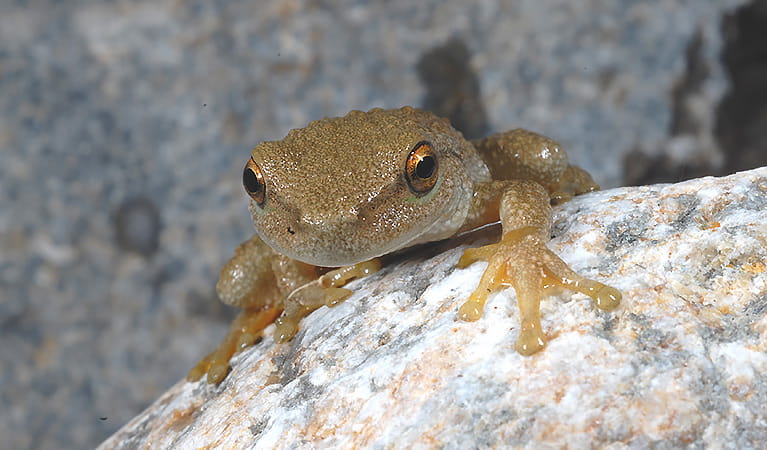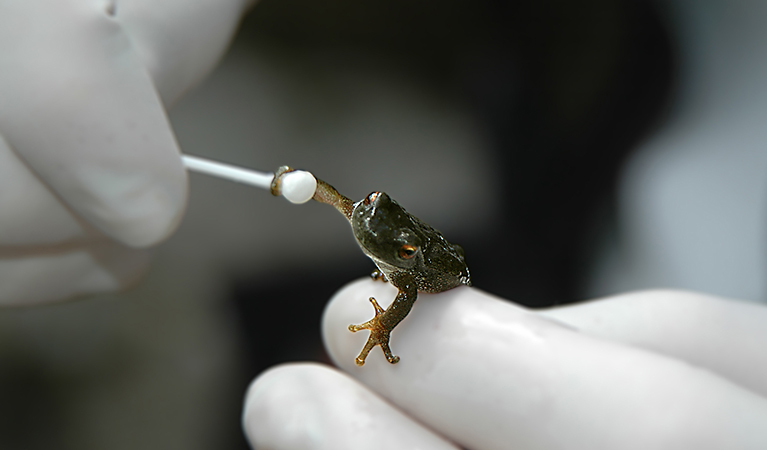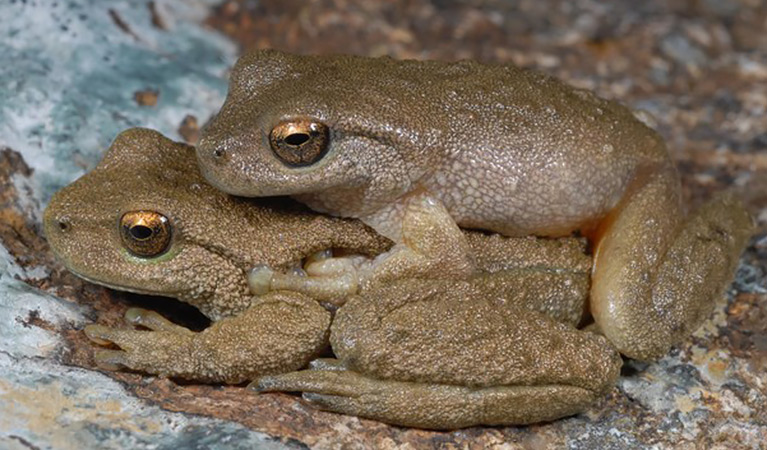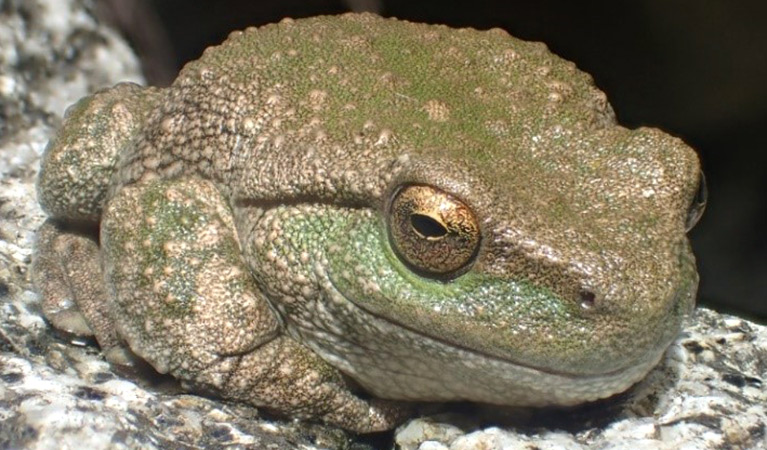Spotted tree frog
The spotted tree frog is a rare Australian frog that lives in only a small number of high mountain streams, including a single location in Kosciuszko National Park. It’s listed as critically endangered in NSW.
Read more about Spotted tree frog
The spotted tree frog is incredibly rare. Its population is dangerously small, with patchy distribution across around 15 fast-flowing streams in Victoria’s central highlands, and just one known location in NSW’s Snowy Mountains.
Ancient beginnings
The spotted tree frog belongs to an ancient group of ground frogs who were already hopping through Gondwanan rainforests, some 40 million years ago.
As Australia tore away from Antarctica and slowly drifted north, it began to dry out, and the cool, moist rainforests shrank. Relict species like ancestors of the spotted tree frog sought refuge in the south-eastern temperate mountain forest streams, amongst the elevated peaks and plateaus of the Southern Alps and great eastern escarpment.
Then, in the 1960s, something started going very badly for the spotted tree frog. First came the introduction of tadpole-devouring trout. But the real killer was the arrival of frog chytrid fungus. This devastating global disease clogs a frog’s skin, affecting their ability to breathe.
Going, going... gone
Historically the NSW population of spotted tree frogs was known from just two streams, in the Upper Murray and Upper Swampy Plains catchments of the Snowy Mountains. By 1998 one of these populations in Kosciuszko National Park had completely disappeared, and the last remaining frogs were succumbing to chytrid infection.
In the summer of 1998, research scientists undertook an emergency rescue operation to collect frogs for captive breeding. They found the remaining wild population in Kosciuszko had just a solitary, lonely male frog, his unanswered mating calls resounding through the catchment. He was the last wild spotted tree frog left in NSW.
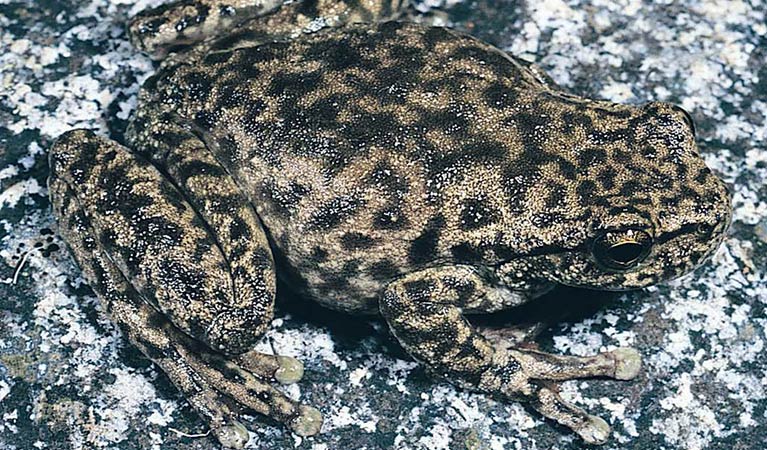
Listen to a spotted tree-frog's call
Audio © David Stewart Naturesound
A 'spawnstar' rises
The long-term survival of the NSW population now rested on the warty shoulders of this sole surviving male frog (who researchers named ‘Dirk Diggler’, after the movie Boogie Nights). With breeding partners sourced from across the Victorian border, Dirk began what would become a decades-long captive breeding operation at the Amphibian Research centre in Melbourne to repopulate wild spotted tree frogs into their former habitat.
Brave new world
Initially, captive-bred frogs thrived after being released back to the wild. Sadly, it wasn’t long before Dirk’s offspring faced infection from chytrid fungus, which once again decimated their numbers in the wild.
But chytrid has a weakness. It doesn’t like environments with temperatures over 28 degrees C. So, in 2014, researchers started an experimental wild colony of spotted tree frogs in a new catchment, with warmer conditions. To everyone’s delight, they thrived.
The higher temperatures of the catchment, along with the frogs’ habit of sun basking on warm rocks along the river, have kept this new population disease free.
Watch footage of captive-bred spotted tree frogs being released in the wild
Animal facts
- Common name
- Spotted tree frog
- Scientific name
- Litoria spenceri
- Conservation status in NSW
- Critically endangered
- Join the Saving our Species movement
- Become a citizen scientist. Take part in Australia’s biggest frog count during FrogID Week held annually in November.
- Learn more about frog chytrid fungus. See how you can help stop it spreading and what to do if you find a sick frog.
A new threat emerges
Just when the future was looking good for this new population, the catastrophic 2019/20 wildfires swept through their catchment. Their numbers were slashed from around 300 frogs before the fires to about a dozen afterwards.
Topped up with another 80 frogs from the Amphibian Research Centre, the remaining wild colony is once more soldiering on, and appears to be regaining lost ground. If any frog ever deserved a break, surely it would be the resilient spotted tree frog of NSW.
Extra protections
The Spotted tree frog is protected as an Asset of Intergenerational Significance (AIS), which adds strong legal protections and management requirements to secure it from extinction.
How you can help
Now more than ever our native wildlife needs our support. Here's how you can help:
You might also like
-
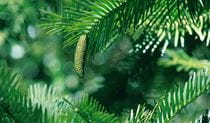
Assets of Intergenerational Significance (AIS)
Assets of Intergenerational Significance (AIS) are declared to bolster protections for an area with exceptional environmental or cultural values, like...
-
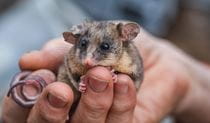
Protecting threatened species in parks
Around 84% of the approximately 900 threatened species in NSW are found in our national parks and reserves. Find out what we're doing to protect threa...
-
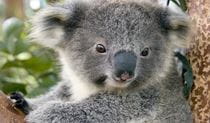
Saving our Species conservation program
Today, we're at risk of losing nearly 1000 of our state's native animals and plants. That's why the NSW Government established Saving our Species. It'...
-
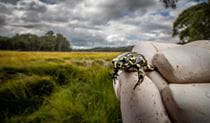
Threatened Species Framework for zero extinctions
The NSW National Parks and Wildlife Service (NPWS) Threatened Species Framework outlines a series of actions to meet our commitment of zero extinction...

